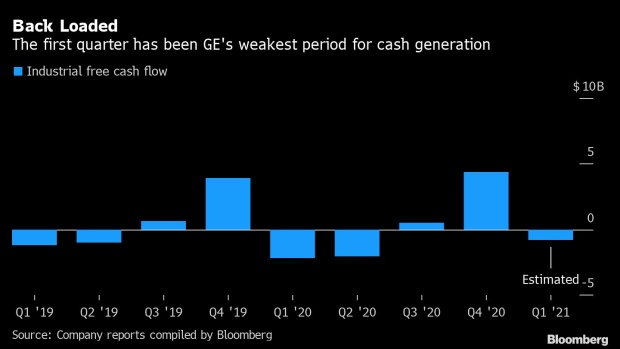Apr 27, 2021
GE slips as aviation woes show much remains on Culp’s to-do list
, Bloomberg News
General Electric near deal with AerCap to combine aircraft leasing unit
General Electric Co. shareholders are getting a reality check from the company’s first-quarter results, a mixed showing that underscored the work ahead for Chief Executive Officer Larry Culp and his turnaround push.
Sales fell 12 per cent to US$17.1 billion, dragged down by the troubled jet-engine unit, GE said Tuesday. That trailed the US$17.6 billion expected by Wall Street. Orders fell in aviation and two other manufacturing units and GE’s steady financial forecast made for a “negative contrast” with conglomerates that have raised their outlook, said John Inch, an analyst at Gordon Haskett.
The report left investors with little to get excited about in the immediate future as Culp continues his efforts to restore some of the company’s lost glory. GE, which surprised Wall Street with a cash-flow rebound in the second half of 2020 and a robust outlook for further gains this year, is now banking on COVID-19 vaccinations to spur air travel and rekindle demand for its jet engines and related services -- all while continuing to fix its other businesses.

Air travel is recovering in the U.S. and activity in China is above 2019 levels, “but you’ve got other parts of the world which are clearly going to be more challenged,” Culp said in an interview. “What’s happening in India is nothing short of a humanitarian crisis and we see that. It’s our second largest footprint for GE, so we’ve got unfortunately very good visibility on all of that.”
The shares fell less than 1 per cent to US$13.45 at 3:43 p.m. in New York after dropping as much as 4.9 per cent for the biggest intraday decline in six weeks. The slide extended a retreat that began in March after GE agreed to sell its aircraft lessor to Ireland’s AerCap Holdings NV. Before that, GE had been rallying strongly this year.
‘Mixed result’
In the first quarter, revenue fell 28 per cent at GE’s jet engine unit while orders tumbled almost as much. The Boston-based company has said it expects annual aviation revenue to be up or flat, driven by a recovery in the second half of the year.
Revenue and orders also dropped in the power-equipment division and health-care unit, which makes medical scanners. Only the renewable energy business posted gains in those categories.
GE’s “mixed result” provided “limited signs of inflection anywhere,” Steve Tusa, an analyst at JPMorgan Chase & Co., said in a report.
Adjusted earnings climbed by a penny to three cents a share, topping the 1.4-cent average of analyst estimates compiled by Bloomberg. GE’s industrial divisions burned US$845 million in the first quarter. Analysts surveyed by Bloomberg had expected cash use of US$663.9 million.
Seasonal weakness
Cash generation is typically weak in the first quarter for GE. Culp said GE was close to breaking even on a cash-flow basis in the period, excluding an US$800 million headwind from the elimination of most of its factoring, a practice in which the company sells receivables to a partner to raise short-term cash.
“We’re encouraged by what we’ve seen in the first quarter,” he said. “We would frame it as a solid start to the year.”
GE included the factoring hit in its first-quarter results, but plans to adjust out the effects starting in the second quarter, Culp said. So while another blow of as much as US$4 billion is likely in the second quarter from the elimination of factoring, that will be excluded from its cash-flow numbers.
“We will take great pains as we go through the year to explain it in a way that represents our underlying operating reality,” Culp said.
Busy quarter
The results cap a busy quarter in which GE announced the US$30 billion air-leasing deal with AerCap. With the transaction, which is expected to close by early next year, GE is unloading the last major vestige of its troubled GE Capital financial-services arm.
The results of what’s left of GE Capital will be reported in the company’s industrial balance sheet. GE has said it plans to use proceeds from the deal to repay another US$30 billion in debt, bringing its total reduction of borrowing since 2018 to US$70 billion.
Culp last year slashed jobs and hoarded cash after the pandemic crushed global air travel and threatened his repair job at GE. The company’s sprawling jet-engine division continues to weigh on results as customers Boeing Co. and Airbus SE contend with weak demand for new planes.
GE’s engine-maintenance business has also been suffering, with U.S. flight departures in mid-April down 30 per cent from pre-pandemic levels. The company tracks departures as a gauge of demand for lucrative spare parts and services.
--With assistance from Richard Clough.





